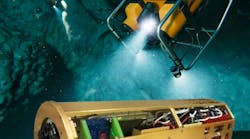By Courtney E. Howard
HUNTINGTON BEACH, Calif.—Industry, academia, and government officials continue to invest heavily in alternative energy sources—ranging from solar and laser power to algae oil—for military and aerospace applications.
An industry team led by The Boeing Co. in Huntington Beach, Calif., won a $15.5 million contract from the Defense Advanced Research Projects Agency (DARPA) in Arlington, Va., for work on Phase 2 of the organization’s Fast Access Spacecraft Testbed (FAST) program to develop an ultra-lightweight, high-power generation system (HPGS) that generates as much as 175 kilowatts.
FAST, combined with electric propulsion, is expected to form “the foundation for future self-deployed, high-mobility spacecraft to perform ultra-high-power communications, space radar, satellite transfer, and servicing missions,” says a Boeing official.
Engineers at Boeing Phantom Works of Huntington Beach, Calif., are leading the effort, with support from Boeing Network and Space Systems in El Segundo, Calif.
Phase 2 activities will include: designing, fabricating, and integrating test articles; performing component-level evaluations; and running full-scale system tests.
“FAST offers significant cost and performance benefits to commercial, civil, and national security customers, including new high-power applications to provide a cost-effective means for spacecraft to travel to the outer solar system,” says Tom Kessler, FAST program manager at Boeing Advanced Network and Space Systems.
The Boeing-led team includes: DR Technologies in Parsippany, N.J.; Northrop Grumman Astro Aerospace in Carpinteria, Calif.; Texas A&M University in College Station, Texas; EMCORE Corp. in Albuquerque, N.M.; Boeing subsidiary Spectrolab Inc. in Sylmar, Calif.; and other key suppliers.
To date, the team has developed a preliminary design for an HPGS providing more than 130 watts per kilogram on a compact system, roughly half the weight and one sixth the size of an existing on-orbit solar power system. “The size efficiency of the HPGS enables a new class of compact spacecraft that can self-deploy from low-Earth orbit to reach final orbit using electric propulsion,” says a representative. “This permits the use of smaller, less expensive launch vehicles that can support high-value science missions to the outer solar system without the need for expensive radioisotope power systems.”
Decision-makers at the U.S. Army’s Research, Development, and Engineering Command (RDECOM) in Picatinny, N.J., have invested $3.1 million with Applied Energetics Inc., of Tucson, Ariz., for the continued development of laser-guided energy (LGE) technology.
The contract, says Joe Hayden, Applied Energetics chief operating officer, signifies the continued commitment of the Army to mature LGE and advance [the company’s LGE] technology to the field.
LGE, considered a transformational weapon technology, involves harnessing and precisely guiding a controllable high-voltage electric charge by a laser through the atmosphere to affect various targets.
“The U.S. Army has been involved with the development of LGE for the past five years,” explains Ben Lagasca, chief of the Advanced Energy Armaments Division at U.S. Army ARDEC, the R&D center for armaments used by the U.S. Army, Special Operations Command, and other organizations. “Now that the technology is approaching the level of maturity needed to begin weaponization, we will be more closely coordinated with Applied Energetics through this contract to fulfill Army mission needs.”
The award is an Ordnance Technology Initiative Agreement with a ceiling of $13.4 million over three years. The initial contract funded value is $3.1 million over one year.
Professionals at Carleton University in Ottawa have launched the Flowing Electrolyte Direct Methanol Fuel Cell (FEDMFC) project. The project, being funded through a grant from Ontario Centres of Excellence, is geared toward refurbishing and bringing to operational status the SymPowerco 5-watt FEDMFC prototype from SymPowerco Corp. in Gardnerville, Nev.
Project team members, all of whom work in Carleton’s Department of Mechanical and Aerospace Engineering, will concentrate on such initial tasks as developing mathematical models to be used for operational simulations and the assessment of virtual and actual FEDMFC data.
U.S. Navy engineers are scheduled to use F-76, an energy fuel derived from algae oil, in the organization’s alternative fuels testing and certification program. In fact, officials at the Defense Energy Support Center, a field activity of the Defense Logistics Agency in Fort Belvoir, Va., awarded Solazyme Inc. in San Francisco a contract for a technology advancing requirement for F-76.
The estimated $8.5 million dollar contract represents the continued commitment by the Department of Defense (DOD) to move toward an environment of energy independence and the use of alternative fuels, says a Solazyme representative.
“This is an important first step with algae oil derived alternative fuels,” adds Kim Huntley, DESC’s director. “Not only are we helping the Navy meet its energy security and alternative fuels objectives, this contract also demonstrates the continued successful partnering of DESC with our warfighter customers to help them meet their emergent energy needs.”
Solazyme’s technology employs new advances in genetic engineering to stimulate strains of algae to produce a diesel fuel that is an alternative to petroleum produced from crude oil.
In other DESC alternative energy news, Sustainable Oils LLC in Seattle won a Hydrotreated Renewable HRJ-5 contract award valued at roughly $2.7 million. The contract for fuel produced solely from camelina feedstock supports the U.S. Navy’s fuel certification testing program of alternative fuels.
“While these contracts are now awarded, we expect more to be announced shortly,” Huntley says. “DESC’s mission is to provide the DOD, other government agencies, and customers with energy solutions in the most efficient and economical manner possible. With continued technology growth in the alternative fuels and renewable energy field, our energy solutions continue to expand. We are moving forward.”


